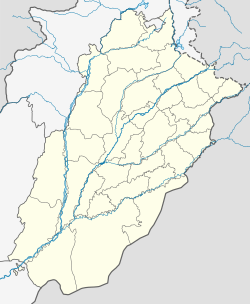Pindigheb (or Pindi Gheb) (Punjabi: پنڈی گھیب), is a town in Punjab province Pakistan and seat of Pindi Gheb Tehsil (an administrative subdivision) of Attock District.[1] Western route of China Pakistan Economic Corridor (CPEC) passes through Pindigheb.
Pindigheb
پنڈی گھیب | |
|---|---|
City | |
| Coordinates: 33°14′28″N 72°16′4″E / 33.24111°N 72.26778°E | |
| Country | Pakistan |
| Province | Punjab |
| District | Attock |
| Tehsil | Pindi Gheb |
| Region | Pothohar |
| Elevation | 310 m (1,020 ft) |
| Population (2023) | |
| • City | 63,810 |
| • Metro | 308,878 (Pindigheb tehsil) |
| Time zone | UTC+5 (PST) |
| • Summer (DST) | UTC+6 |
| Area code | 0572 |
| Website | Tehsil Municipal Administration Pindi Gheb |
History
editThe Imperial Gazetteer of India, compiled over a century ago during British rule, described the town as follows:[2]
Pindi Gheb Town.-Head-quarters of the subdivision and tahsil of the same name in Attock District, Punjab, situated in 33º 14' N. and 72º 16' E., 21 miles from Jand station on the North-Western Railway. Population (1901), 8,452. Formerly known as Pindi Gheb drives from two words pindi which means town and Gheba who was a Gurkani Mughal Prince,Cousin of babur, Ancestor of Royal Gurkani Mughal Sardar family of Gheba and is now the ancestral home of the Johdra Rajputs and Ghebas, who founded it in the 15th century. The municipality was created in 1873. The income and expenditure during the ten years ending 1902-3 averaged Rs. 4,400. In 1903-4 the income was Rs. 5,200, chiefly from octroi; and the expenditure was Rs. 5,800. A vernacular middle school is maintained by the municipality, and a dispensary by Government.
In 997 CE, Sultan Mahmud Ghaznavi, took over the Ghaznavid dynasty empire established by his father, Sultan Sebuktegin, In 1005 he conquered the Shahis in Kabul in 1005, and followed it by the conquests of Punjab region. The Delhi Sultanate and later Mughal Empire ruled the region. The Punjab region became predominantly Muslim due to missionary Sufi saints whose dargahs dot the landscape of Punjab region.
After the decline of the Mughal Empire, the Sikh invaded and occupied Attock District. The Muslims faced severe restrictions during the Sikh rule [citation needed]. During the period of British rule, Attock District increased in population and importance.
The predominantly Muslim population supported Muslim League and Pakistan Movement. After the independence of Pakistan in 1947. The name of incumbent Assistant Commissioner of Pindi Gheb sub division is Ijaz Abdul Karim.
Present Day
editPindi Gheb is an important region of trade and acts as an important terminal for the mega highway CPEC. The main economy of Pindi Gheb revolves around agriculture and cattle. The towns local government, however, according to local residents has failed numerous times to provide the town with any real infrastructural or educational developments. The relative population of the town still remains poor with low-grade roads and bridges. Contrary to such statements, some of the richest families in Northern Punjab come from Pindi Gheb, with them owning thousands of acres of lands, huge properties both abroad and in urban centers in Pakistan, heavy presence in the industrial sector and close affiliation with people affiliated with the military and government. However, recently many reforms were passed by the government of Punjab to commence energy and road projects in Attock, including Pindi Gheb. There are many monuments present in Pindi Gheb from the Sikh and British eras which can be visited free of cost. There is also a waterfall nearby known to harbor a rare species of fish. The area is known to be relatively safe as it is included in the zone of "Act for the Super fortification for the North West Districts of Punjab" which is done with the use of Attock fort, known to be located close by. Pindi Gheb can today be visited by the CPEC, or 8 local roads that lead towards the city through other paths inside of Attock.
Demographics
editPopulation
edit| Census | Population[3] |
|---|---|
| 1972 | 17,982 |
| 1981 | 20,535 |
| 1998 | 29,850 |
| 2017 | 45,195 |
| 2023 | 63,810 |
Language
editAs with the rest of Pakistan, Urdu has official status. However, the language variety spoken natively in the area is Ghebi – a Hindko dialect that is closely related to Chacchi and Awankari.[4]
References
edit- ^ Tehsils & Unions in the District of Attock – Government of Pakistan Archived 2012-02-09 at the Wayback Machine
- ^ Pindi Gheb Town - Imperial Gazetteer of India, v. 20, p. 147.
- ^ "Punjab (Pakistan): Urban Localities in Districts - Population Statistics, Charts and Map". www.citypopulation.de. Retrieved 2024-08-31.
- ^ Shackle 1980, p. 484.
Bibliography
edit- Shackle, Christopher (1980). "Hindko in Kohat and Peshawar". Bulletin of the School of Oriental and African Studies. 43 (3): 482–510. doi:10.1017/S0041977X00137401. ISSN 0041-977X.
- Gazetteer of Attock 1934

